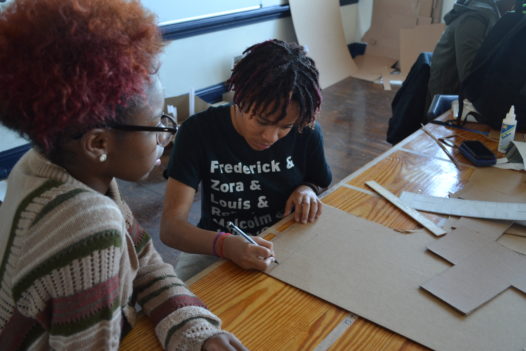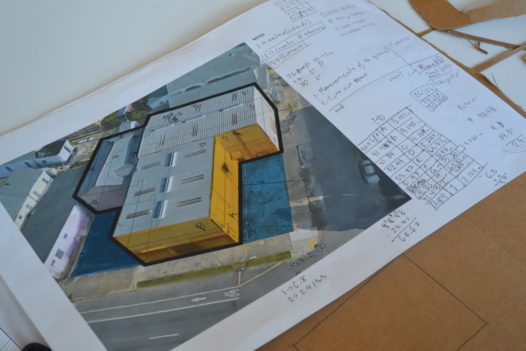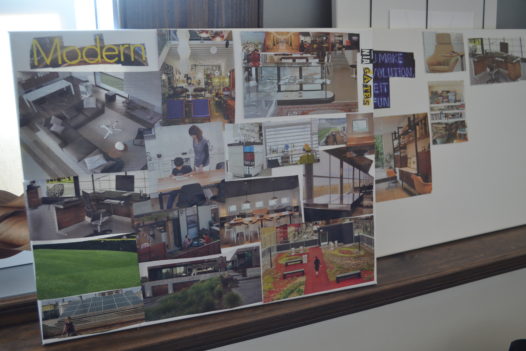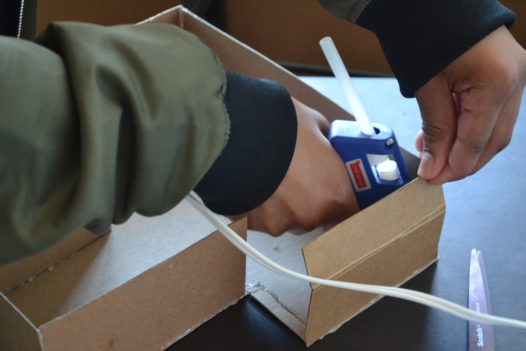
BECNO students working on design for “recreational church” (Photos by: Kelley Crawford)
Bard Early College New Orleans, endearingly known as BECNO, has found a home at Kipp Renaissance High School. Around 1:00 p.m. every afternoon, the back hallway on the third floor bustles with students seeking college credit and conversation around questions like “What is privacy?” or “What does it mean to be human?” Nestled among the classrooms is one room where the tables have been transformed into New Orleans city blocks–thanks to the help of masking tape and precise lines–and small scale models of the surrounding neighborhoods stack against the wall. It is the classroom of professor Bryan C. Lee, and the course is “Architecture and Social Injustice.”
“The course is focused around design justice,” Lee, the president elect for the Louisiana chapter of the National Organization of Minority Architects as well as a member of the Arts Council and the AI Diversity and Inclusion committee, says. Linking together justice and architecture is a constant endeavor for Lee. As he sees it, “When you see dilapidated properties; when you see properties that have not been taken care of in a long time or [properties] the city is allowing to fall apart, that means something. That means [the city] values it less.”
Connecting Lee’s passion with BECNO’s mission to engage their students with difficult questions and community-oriented thinking has allowed the students to problem solve issues plaguing New Orleans and formulate solutions that have community impact.

Design plan for BECNO’s “Architecture and Design Thinking” course (Photos by: Kelley Crawford)
“There’s a lot of creativity that goes on with architecture,” Kennedy London, a senior at BECNO says. “It’s like a brain teaser, and it’s challenging and worthwhile to do.” The challenge and brain teaser for Lee’s class this semester hit close to home since the building the students designed sat across the street from their school. The building belongs to Sherdren Burnside, also knows as “The Client,” to the students.
As BECNO senior Nia Gates explains, “The client wants [the building] to be a church and community center. It’s a place where people can have opportunities, so we’re putting in spots for youth centers, jobs, a game room, a church, a gym; I think of it as a recreational church.”
While the students calculate, measure, cut, and create, their focus sharply imagines not only what this building could be for the community but also their role in this currently vacant space. “We’re trying to figure out what can be work spaces, children’s spaces, art spaces, and making sure that the youth is included in the design,” BECNO junior Asia Polk says. “We don’t want kids to feel like all they can do is stand out in the street. This church is something to help get the community and kids on a better track.”

Inspiration boards for design brainstorming with “Architecture and Social Injustice” course (Photos by: Kelley Crawford)
Constructing space for the youth and providing a stage for the youthful voice is ubiquitous in Lee’s work. He helps spearhead Project Pipeline, the mentorship program that bridges youths interested in design and design professionals together, and he is currently engaged in a project where selected high schooler play what he describes as a “design game.” The game’s goal is to fight gentrification and design injustice by addressing and rethinking current and possible policies that the city endorses. Even if many of us are well past our youthful days, Lee says there are still ways to keep that skip in our professional step. “Talk to the young people,” he says. “Include them within the community at large as we start to talk about community engagement or perpetual engagement. That’s where we want to be. In a space where the built environment has advocates from a young age.”

BECNO student constructing “recreational church” model (Photos by: Kelley Crawford)
The advocates that Lee and BECNO have fostered through the “Architecture and Social Injustice” course are voices full of devotion and spirit. As Kenneth Bailey, a senior at BECNO, sketches out one of the rooms he will submit to Ms. Burnside, he electrically confesses that he wants to major in architecture. What was his inspiration? The Superdome.
“Look at the Superdome,” he says. “It curves in. Who in the world thinks, ‘I’m going to make a building where the walls curve in’? Also there’s the fact that this city is built on mud, so now you have to think about how to get one of the heaviest buildings in the city to stand on mud and not sink. It should have been a disaster, but it’s wonderful. That shows some genius. We went from living in caves to building a building like the Superdome.”
We have come a long way since our days in caves, and we all know that we have a long way to go. With professors like Bryan C. Lee and institutions like BECNO advocating for critical thought, community engagement, and inspirational creativity, that long way sounds like a path worth taking.
Bryan C. Lee will be holding a Design As Protest gathering at Tulane City Center on January 20 from 12:00 p.m. until 4:00 p.m. for anyone interested in discussing and addressing issues of injustice throughout the built environment.
 NOLAbeings Multimedia artist Claire Bangser created NOLAbeings as a portrait-based story project that marries...
NOLAbeings Multimedia artist Claire Bangser created NOLAbeings as a portrait-based story project that marries...  Voodoo in New Orleans: Reviving history: New Orleans fortune telling This article takes a deep dive into the history of Voodoo in New Orleans, its hybridization with Catholicism, and its present-day place in the city's culture. The author visits fortune-tellers in the French Quarter, using their guidance as a tool for introspection rather than a deterministic predictor of the future. Through her experiences in New Orleans, the author feels a mystical connection to both the past and the future.
Voodoo in New Orleans: Reviving history: New Orleans fortune telling This article takes a deep dive into the history of Voodoo in New Orleans, its hybridization with Catholicism, and its present-day place in the city's culture. The author visits fortune-tellers in the French Quarter, using their guidance as a tool for introspection rather than a deterministic predictor of the future. Through her experiences in New Orleans, the author feels a mystical connection to both the past and the future. 